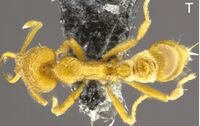Strumigenys gunter
| Strumigenys gunter | |
|---|---|

| |
| Scientific classification | |
| Kingdom: | Animalia |
| Phylum: | Arthropoda |
| Class: | Insecta |
| Order: | Hymenoptera |
| Family: | Formicidae |
| Subfamily: | Myrmicinae |
| Tribe: | Attini |
| Genus: | Strumigenys |
| Species: | S. gunter |
| Binomial name | |
| Strumigenys gunter Sarnat, Hita-Garcia, Dudley, Liu, Fischer & Economo, 2019 | |
Identification
Strumigenys gunter is a small shiny pale-yellow species with small eyes of one to several facets, abundant long flexous hairs on metasomal dorsum, and shorter subdecumbent hairs on the promesonotum. It morphologically similar to a cluster of species related to Strumigenys chernovi, but is immediately distinguished by the smaller eyes. Additional diagnostic notes are given under S. chernovi. Strumigenys gunter is only known from three worker specimens collected on Gau and Koro.
Distribution
Distribution based on Regional Taxon Lists
Indo-Australian Region: Fiji (type locality).
Distribution based on AntMaps
Distribution based on AntWeb specimens
Check data from AntWeb
Countries Occupied
| Number of countries occupied by this species based on AntWiki Regional Taxon Lists. In general, fewer countries occupied indicates a narrower range, while more countries indicates a more widespread species. |

|
Biology
Castes
Strumigenys X-ray micro-CT scan 3D model of Strumigenys gunter (worker) prepared by the Economo lab at OIST.
X-ray micro-CT scan 3D model of Strumigenys gunter (worker) prepared by the Economo lab at OIST.
Strumigenys FJ14. See on Sketchfab. See list of 3D images.
Strumigenys X-ray micro-CT scan 3D model of Strumigenys gunter (worker) prepared by the Economo lab at OIST.
X-ray micro-CT scan 3D model of Strumigenys gunter (worker) prepared by the Economo lab at OIST.
Strumigenys FJ04. See on Sketchfab. See list of 3D images.
Nomenclature
The following information is derived from Barry Bolton's Online Catalogue of the Ants of the World.
- gunter. Strumigenys gunter Sarnat, Hita-Garcia, Dudley, Liu, Fischer & Economo, 2019: 36, figs. 7J, 9S, 9T, 18, 27, Model 4 (w.) FIJI.
Description
Worker. Measurements (n = 2): TL 2.41–2.44 mm, HL 0.55–0.58 mm, HW 0.39–0.43 mm, CI 70–74, MdL 0.23–0.27 mm, MI 42–47, SL 0.37–0.41 mm, SI 81, PW 0.24–0.26 mm, PI 59–61, FL 0.37–0.41 mm, FI 94–96, EL 0.24–0.26 mm. Color a pale yellowish-brown. Mandibles long and linear with one preapical tooth; preapical tooth length approximate to maximum mandible width. Apicoscrobal hair short and simple, weakly projecting laterally but not filiform or flagellate. Cephalic dorsum uniformly reticulate-punctate. Ground pilosity of cephalic dorsum short, simple, strongly curved. Pronotal humeral hairs thin, flexuous, of moderate length. Promesonotal dorsum with short curved ground pilosity and two pairs of longer erect hairs in addition to humeral pair. Pronotal dorsum with weak longitudinal striae. Mesonotal dorsum weakly reticulate-punctate. Propodeal dorsum smooth and shining. Pronotal sides weakly striate apically; remainder of mesosomal sides smooth and shining. Propodeal tooth short, narrowly triangular, embedded in lamella. Lamella forming convex curtain along propodeal declivity. Femur and tibia of hind leg both with single filiform projecting hair on dorsal surface. Petiolar node in profile with anterior face slightly steeper and shorter than posterior face; lateral spongiform lobe small; restricted to posterior margin of node. Dorsum of petiole and petiolar disc smooth and shining; each with two pairs of filiform to flagellate hairs. Ventral lobe of postpetiole spongiform. First gastral tergite with erect filiform hairs. Basigastral sculpturing consists of broadly spaced costulae shorter in length than postpetiolar disc.
References
- Liu, C., Sarnat, E.M., Friedman, N.R., Hita Garcia, F., Darwell, C., Booher, D., Kubota, Y., Mikheyev, A.S., Economo, E.P. 2020. Colonize, radiate, decline: Unraveling the dynamics of island community assembly with Fijian trap‐jaw ants. Evolution 74, 1082–1097 (doi:10.1111/EVO.13983).
- Sarnat, E.M., Hita-Garcia, F., Dudley, K., Liu, C., Fischer, G., Economo, E.P. 2019. Ready species one: Exploring the use of augmented reality to enhance systematic biology with a revision of Fijian Strumigenys (Hymenoptera: Formicidae). Insect Systematics and Diversity 3(6): 6; 1–43 (doi:10.1093/isd/i*Wang, C., Lin, C.-C., Keller, R.A., Billen, J. 2021. The ‘hairwheels’ in Strumigenys ants are not glandular. Asian Myrmecology 13: e013004 (doi:[https://doi.org/10.20362%2Fam.013004 10.20362/am.013004).
xz005]).

